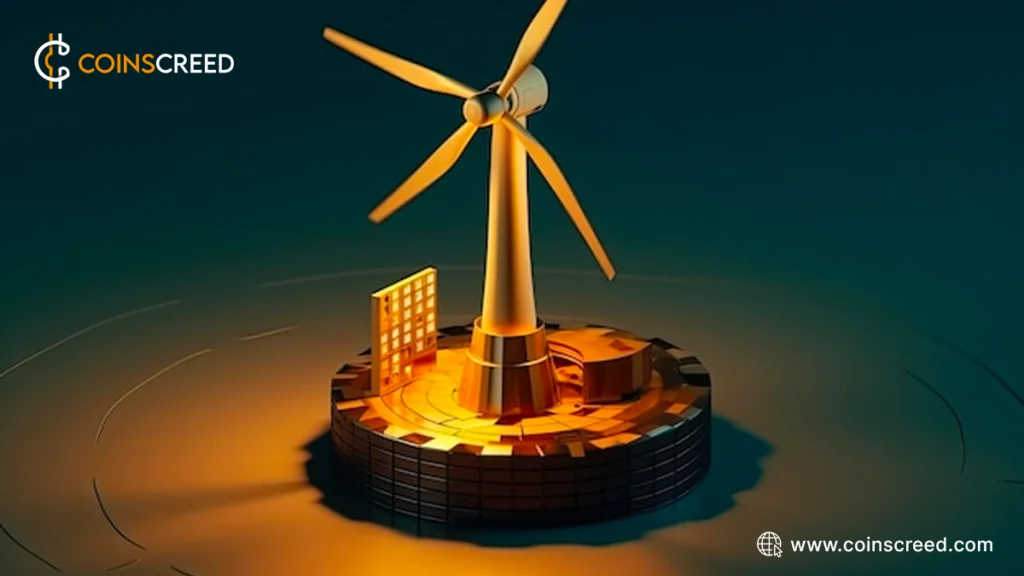Blockchain technology keeps evolving and proving its relevance in diverse sectors. Here, we discuss how blockchain technology empowers renewable energy. Read to the end so as not to miss any detail.

In our current global climate, the urgency of embracing sustainable energy sources has never been more apparent. The demand for efficient and transparent renewable energy systems is at an all-time high, and an unexpected ally has emerged: blockchain technology.
This article comprehensively examines how blockchain revolutionizes renewable energy, enhancing its efficiency, accessibility, and reliability.
Understanding Blockchain Technology
Blockchain, renowned as the technology underlying cryptocurrencies like Bitcoin, operates as a decentralized and tamper-proof digital ledger. Information gets stored in blocks, which are unalterable once added to the chain. This unique feature ensures high security and transparency, extending its potential beyond financial applications.
What is Renewable Energy
Renewable energy pertains to energy harnessed from naturally replenished sources within a human timeframe, ensuring long-term availability. In contrast to finite fossil fuels like coal, oil, and gas, renewable energy sources are enduring and have minimal adverse environmental effects.
Common examples of these sources encompass sunlight (solar energy), wind, water (hydroelectric and tidal energy), geothermal heat, and biomass (organic materials such as wood, agricultural remnants, and waste). These resources offer a cleaner and more sustainable option than traditional energy sources, thereby actively contributing to addressing climate change and curbing emissions of greenhouse gasses.
Blockchain Technology’s Integration with the Renewable Energy Industry
The integration of blockchain with renewable energy indeed has significant benefits. Here’s a list of some of the ways by which blockchain technology is enabling a more seamless process in the renewable energy industry:
- Peer-to-Peer Energy Trading
- Microgrids and Energy Communities
- Traceability and Certifications
- Grid Management and Efficiency
- Funding Renewable Energy Projects
- Data Security and Privacy
- Energy Tokenization
- Decentralized Energy Storage
- Carbon Credits and Emissions Reduction
- Interoperability and Standardization
1. Peer-to-Peer Energy Trading
The most remarkable shift blockchain catalyzes is likely in peer-to-peer (P2P) energy trading. Traditional energy distribution models are rooted in centralized utilities governing electricity flow and pricing.
However, through blockchain, individuals can directly purchase and sell excess energy from their renewable sources to their peers or the grid. This decentralized approach empowers individuals and diminishes the need for intermediaries, streamlining energy distribution.
2. Microgrids and Energy Communities
Blockchain’s facilitation of P2P energy trading contributes significantly to the emergence of microgrids and energy communities. These localized systems empower communities to generate, store, and allocate renewable energy.
Also, by guaranteeing secure, transparent, and automated energy transactions, blockchain paves the way for increased energy independence and resilience during emergencies or power outages.
3. Traceability and Certifications
Blockchain’s transparency revolutionizes the validation and origins of renewable energy. For instance, the veracity of renewable energy certificates (RECs) can be securely tracked through blockchain, affirming the renewable source of a particular energy amount.
This transparency empowers consumers to make informed energy choices and aids corporations in achieving their sustainability objectives.
4. Grid Management and Efficiency
The decentralized nature of blockchain offers potential enhancements in energy grid management and efficiency. Smart contracts can automate load balancing and demand response tasks, optimizing energy distribution and curtailing wastage, thereby elevating overall grid efficiency.
5. Funding Renewable Energy Projects
Blockchain introduces innovative avenues for funding renewable energy initiatives. Investors can directly contribute to these projects through Initial Coin Offerings (ICOs) or Security Token Offerings (STOs), thus, simplifying funding and potentially reducing costs. This democratization of investment can expedite the shift to clean energy solutions.
6. Data Security and Privacy
As data collection and analysis become pivotal in the renewable energy sector, blockchain’s decentralized structure and encryption help support the security and privacy of sensitive energy data. This becomes especially critical with the growing integration of Internet of Things (IoT) devices in energy systems.
7. Energy Tokenization
Beyond its financial applications, blockchain’s influence on renewable energy extends to energy tokenization. This concept involves representing energy units as digital tokens on a blockchain.
These tokens can then be traded, purchased, or sold, introducing greater flexibility and efficiency to energy transactions. The concept of a token economy introduces the potential to incentivize energy conservation and efficiency.
For example, users might earn tokens for using energy during off-peak periods or generating surplus renewable energy. This establishes a framework that rewards sustainable practices and aligns consumer actions with grid demands.
8. Decentralized Energy Storage
While the emphasis has been mainly on energy generation and distribution, energy storage is equally vital to a dependable renewable energy framework, and blockchain technology can be harnessed to create decentralized energy storage systems.
These systems allow individuals or entities with excess energy to lend or sell their stored energy to those in need. Through smart contracts, the automated release and transfer of energy based on predefined conditions further refine the energy allocation process.
9. Carbon Credits and Emissions Reduction
Blockchain’s features of transparency and immutability find a fitting application in tracking carbon credits and efforts to reduce emissions. Carbon credits signify a decrease in greenhouse gas emissions and can be traded, sold, or bought.

By utilizing blockchain, the entire lifecycle of carbon credits – spanning creation, verification, and trading – can be securely documented. Hence, this reinforces accountability in emissions reduction initiatives and establishes a reliable mechanism to confirm the attainment of environmental objectives.
10. Interoperability and Standardization
Ensuring interoperability and standardization becomes pivotal as the renewable energy landscape diversifies with various technologies and stakeholders. Here, blockchain plays a role in establishing universal standards and protocols, thereby, fostering seamless communication and interaction among different renewable energy systems.
This interoperability guarantees smooth data and transaction flow across diverse platforms and technologies, ultimately enhancing efficiency and collaboration within the renewable energy sector.
These insights underscore the multifaceted ways blockchain technology is reshaping the renewable energy domain, offering innovative solutions to address some of the industry’s most pressing challenges.
Conclusion
Blockchain technology’s influence on renewable energy signifies a breakthrough in combating climate change. Blockchain reshapes the energy landscape by enabling P2P energy trading, encouraging microgrids, ensuring traceability, optimizing grid management, facilitating project financing, and more discussed above.
Also, with ongoing technological advancements and collaborative efforts, we can anticipate a more decentralized, efficient, and sustainable energy future powered by blockchain’s transformative capabilities.
